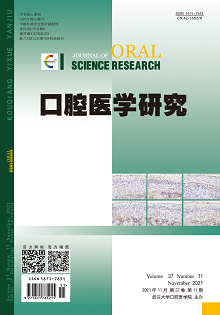|
|
Analysis of Periodontal Biotype Distribution and Related Factors of Maxillary Anterior Teeth of Youth in Different Nationalities in Xinjiang
CHEN Miaomiao, SHEN Yufeng, GOU Xiaorui, YU Chongqing, LI Qian, YUE Haifeng, JIANG Dandan, HUANG Meiyu, ZHOU Zheng
2021, 37(11):
999-1003.
DOI: 10.13701/j.cnki.kqyxyj.2021.11.009
Objective: To assess the morphological characteristics of different tooth sites, sex, and ethnic groups, and evaluate their correlation to gingival biotype (GB). Methods: Periodontal phenotypes in 335 healthy individuals from four ethnic groups in the Xinjian region of China were investigated. Clinical and dental stone measurements were used to establish the crown width (CW) and length (CL) and its ratio, attached gingival width (AGW), and probing depth (PD). GB association with sex, ethnic group, smoking status, alcohol consumption, BMI, toothbrushing habits and patterns, and mouthwash use, was evaluated. Results: CW, CL, CW/CL, and AGW among maxillary anterior teeth were different significantly (P<0.001). There were significant differences in the distribution of GB in different teeth positions (P<0.001). The thick gingival biotypes were 60.1%, 37.9%, and 26.1% in incisors, lateral incisors, and canines, respectively (P<0.05). There were differences in CL, CW/CL ratio and AGW in different ethnic groups (P<0.05). The thick gingiva biotype of maxillary anterior teeth was more in male and Uygur and Kazakh ethnic group. People with smoking manner and higher BMI (18.5 kg/m2≤BMI<25 kg/m2, BMI≥25 kg/m2) had more thick gingival biotypes. There were more thin gingival biotypes in the group of drinking and brushing vertically and horizontally (P<0.05). Conclusion: Significant differences were found in dentogingival measurements according to tooth position and ethnicity. Factors related to GB according to tooth position varied significantly, but sex and ethnicity had marked effects.
References |
Related Articles |
Metrics
|

